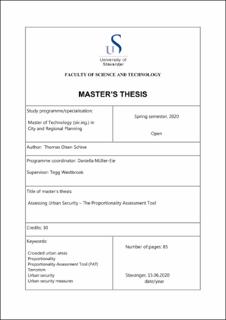| dc.description.abstract | Cities and crowded urban areas are increasingly becoming targets of terrorist attacks. They are attractive because they are easily accessible and provide a plethora of high value assets. Even though they have been targeted frequently over the last century, fatal consequences have increased over the latest few decades (Jenkins & Butterworth, 2019; Law, 2009). Both the Al Qaeda and the IS have changed the means of terrorism by lowering the effort to achieve most possible harm. They have turned vehicles into rams, and it has never been easier to construct an IED with instructions found on the internet (Burke, 2018).
Society has become increasingly familiar with terrorism. The importance of urban security is being addressed, and cities are now adapting to the threats through resilience and by retrofitting urban security measures into the built environment. The response has, however, also brought with it disproportional and irrational urban security measures at the expense of both townscape aesthetics and liveability. In Norway, there are two main reasons for this. One is tied to the city governments’ and municipalities’ incapacity to deal with urban security (Westbrook & Jore, 2020). The other is the lack of a toolbox for assessing it. As a result, we have seen obtrusive anti-riot trucks blocking off roads in the city centre of Oslo during the children’s 17th of May parade and dumper trucks parked all over Arendal square during the Christmas tree lighting ceremony in 2017.
Not only do such security measures come at the expense of people’s perception of security, they also deeply influence the lives of citizens (Sennett, 2018). But we must not forget where the problem originates. Disproportional security measures are the consequence of poor assessments. How can we expect that assessors will be able to select proportional security measures, when they are only given tools that rely on their own subjective interpretation of urban security?
The thesis helps us deal with this issue. It uses proportionality as key to provide us with a new tool for assessing urban security: The Proportionality Assessment Tool. The tool is supplementing the existing framework such as the ISR and the NS 5832. It is built on the idea of an expanded, contextual definition of proportionality that comes with two new abilities: Performance and Design. ‘Performance’ ensures that the measures do the job and ‘Design’ ensures that it is done in an appropriate manner. Together, they give us a measure of proportionality and thus allows us to prioritize urban security measures thereafter.
The tool must, however, be used carefully. Its research methodology leads to certain uncertainties and requirements for use since it is developed by using trial and error, and its trials have been of limited extent. We must, therefore, make sure that we follow the tool’s guidelines whenever we use it. Otherwise, we cannot – and should not – rely on it. | en_US |

